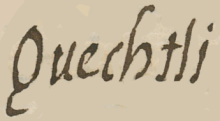quechtli (FCbk10f80v)
This iconographic example, featuring a human neck (quechtli), is included in this digital collection for the purpose of making possible comparisons with related hieroglyphs. The term selected for this example comes from the Nahuatl text near the image in the Digital Florentine Codex. There is no gloss, per se. This example shows the top of a torso with shoulders, resting on a green grassy field. Up from the torso comes a neck (quechtli), and out of the top of the neck emerge blood vessels or blood (eztli, a DFC keyword) spraying from vessels. The artist may have been aware that carotid arteries run through human necks, and so when a body is decapitated, a lot of blood can spray out. But the drama may surprise some viewers. The blue band of sky and the green ground that can be seen in the contextualizing image are artistic elements that the tlacuilo has learned as a part of the education provided by Catholic friars. This is true, too, of the shading that gives the torso and neck some three-dimensionality. The presence of the partial body resting on grass almost makes it seem like a part of the landscape, such as a volcano spewing lava. But that is probably not the intention.
Stephanie Wood
While throats and necks appear in many hieroglyphs of a human head or full body, they are rarely singled out. One fun example from the Matrícula de Huexotzinco shows a profile of the head of a man. Around his throat (tozquitl, another term for throat and for voice) is a ring of feathers, presumably from the yellow-headed parrot (toztli, providing a phonetic indicator for tozquitl). Tozquitl also refers to someone with a good singing voice, so several people with the name Tozquihua (“He Has a Voice,” or “He Sings Well”) involve feathers and song scrolls more than throats.
Stephanie Wood
Quechtli
quechtli
Stephanie Wood
1577
Jeff Haskett-Wood
quechtlantli, tozquitl, cuellos, gargantas, sangre, torso, cuerpo
quech(tli), throat or neck, https://nahuatl.wired-humanities.org/content/quechtli
el cuello, la garganta
Stephanie Wood
Available at Digital Florentine Codex/Códice Florentino Digital, edited by Kim N. Richter and Alicia Maria Houtrouw, "Book 10: The People", fol. 80v, Getty Research Institute, 2023. https://florentinecodex.getty.edu/en/book/10/folio/80v/images/0 Accessed 10 September 2025.
Images of the digitized Florentine Codex are made available under the following Creative Commons license: CC BY-NC-ND (Attribution-NonCommercial-NoDerivs 4.0 International). For print-publication quality photos, please contact the Biblioteca Medicea Laurenziana ([email protected]). The Library of Congress has also published this manuscript, using the images of the World Digital Library copy. “The Library of Congress is unaware of any copyright or other restrictions in the World Digital Library Collection. Absent any such restrictions, these materials are free to use and reuse.”





